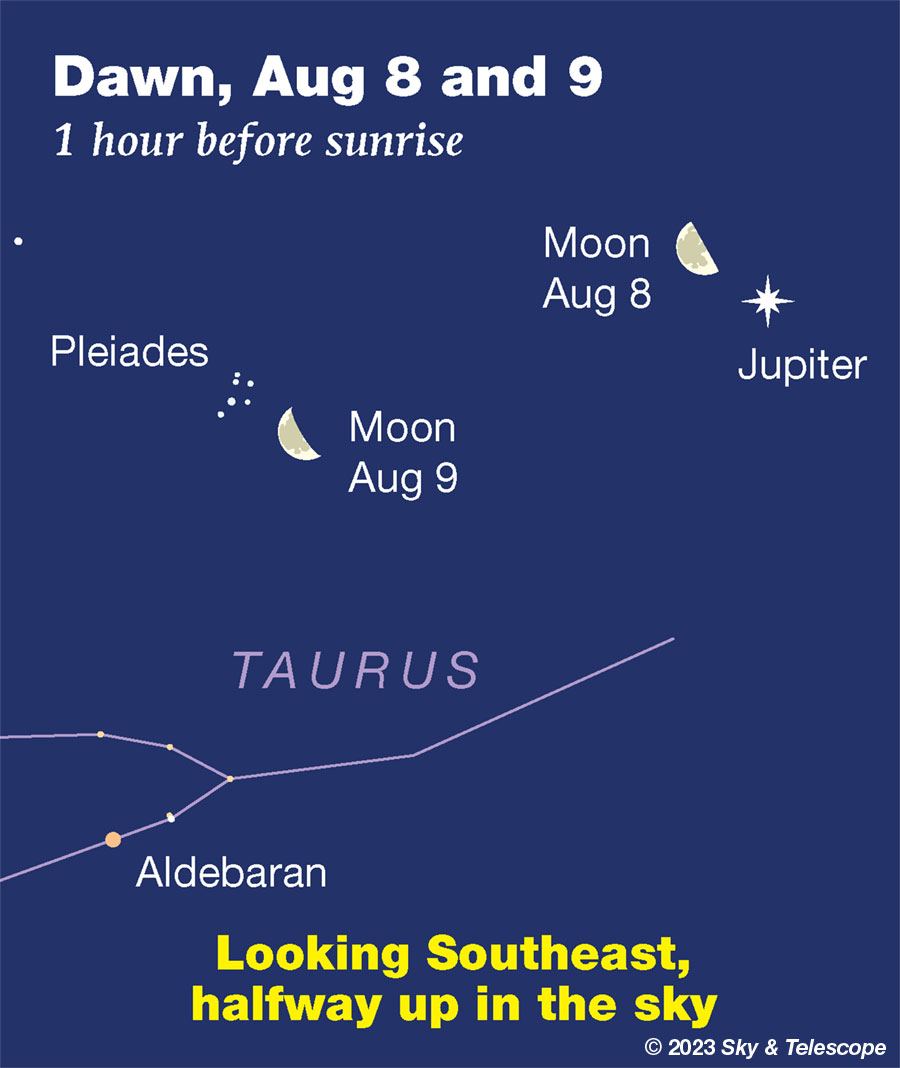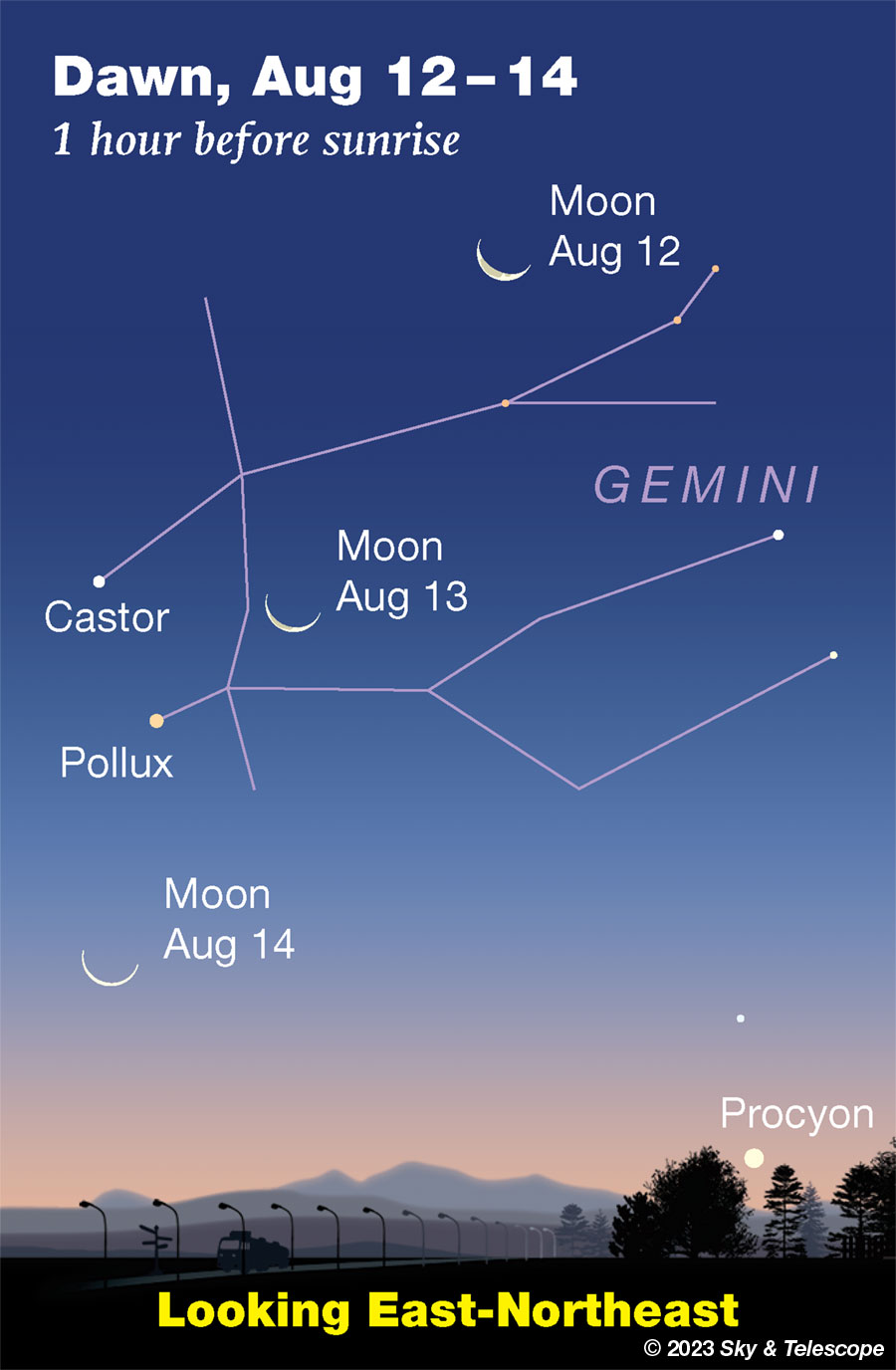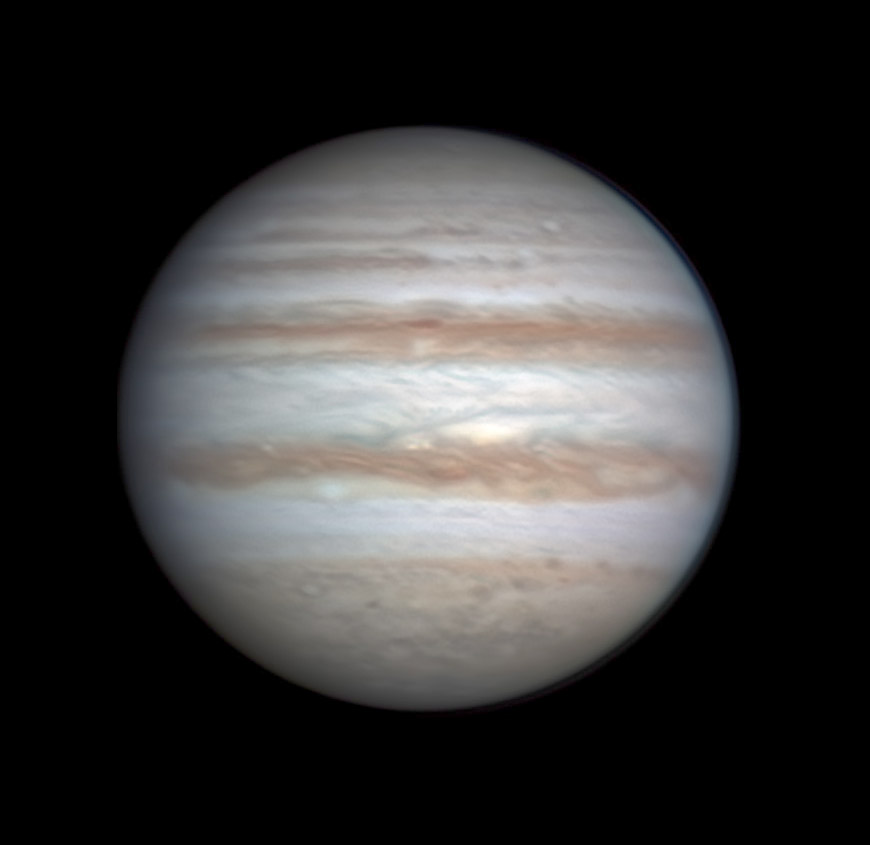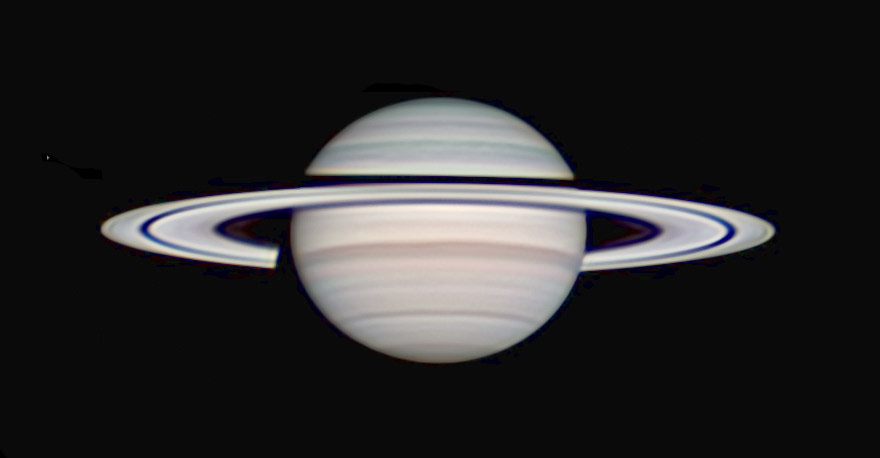FRIDAY, AUGUST 4
■ Fourth star of the Summer Triangle? The next-brightest star near the Summer Triangle, if you'd like to turn it into a quadrilateral, is Rasalhague, the head of Ophiuchus, magnitude 2.1. Face south soon after dark. You'll find Rasalhague about equally far to the right of Altair and lower right of Vega. Altair is currently the Summer Triangle's lowest star. Vega, nearly overhead, is its brightest.
SATURDAY, AUGUST 5
■ Bright Vega passes closest to overhead around 10 or 11 p.m., depending on how far east or west you live in your time zone. How closely it misses your zenith depends on how far north or south you are. It passes right through your zenith if you're at latitude 39° north (Washington DC, Cincinnati, Kansas City, Lake Tahoe). How closely can you judge this just by looking?
Deneb passes the zenith two hours after Vega. To see Deneb exactly straight up, you need to be at latitude 45° north: for example Portland (either Oregon or Maine), Minneapolis, Montreal, southern France, northern Italy, southern Ukraine.
SUNDAY, AUGUST 6
■ The Big Dipper hangs diagonally in the northwest after dark. From its midpoint, look to the right to find Polaris (not very bright) glimmering due north as always.
Polaris is the end of the Little Dipper's handle. The only other Little Dipper stars that are even modestly bright are the two forming the outer end of its bowl: 2nd-magnitude Kochab and 3rd-magnitude Pherkad. On August evenings you'll find them to Polaris's upper left (by about a fist and a half). They're called the Guardians of the Pole, since they ceaselessly circle Polaris all night and all year.
MONDAY, AUGUST 7
■ Seeing any early Perseid meteors yet? A few Perseids trickle in starting in late July, then they build for a couple of days toward their peak, which this year is predicted for the night of August 12-13. The sky then will be moonless for perfect meteor-watching conditions. See August 12 below. The weak, long-lasting Delta Aquariid shower is still somewhat active throughout this period. For both showers, the later in the night the more abundant the meteors.
■ Last-quarter Moon tonight (exactly last quarter at 6:28 a.m. Tuesday morning EDT). The Moon rises around 11 or midnight tonight with Jupiter following just a couple degrees below it. Before the start of dawn they're very high in the southeast as shown below, favorite telescopic sights both! And as a bonus Uranus, magnitude 5.7, is 7° or 8° east of the Moon (you'll need a detailed finder chart for it).
The Pleiades look on. Far below the Pleiades and Aldebaran, Orion is beginning its emergence before sunrise.

TUESDAY, AUGUST 8
■ As summer progresses, the Big Dipper scoops down in the northwest during evening as if to pick up the water that it will dump from high overhead early next spring.
■ Also as summer progresses, bright Arcturus moves down the western side of the evening sky left of the Dipper. Arcturus forms the bottom point of the Kite of Boötes. The Kite, rather narrow, extends upper right from it by 23°, about two fists at arm's length.
The top of the kite is bent slightly down. The kite's short tail flutters down from Arcturus.
WEDNESDAY, AUGUST 9
■ A binocular challenge. The evening sky is moonless, and if you are blessed with little or no light pollution, now is a good time to have at the famous North America Nebula close by Deneb high overhead. It's famous but dim, diffuse, and visually elusive. The nebula is a good 1° or 2° across, so use large, richest-field binoculars or your telescope's lowest-power, widest-field eyepiece. Use the chart and description in Matt Wedel's Binocular Highlight column in the August Sky & Telescope, page 43.
THURSDAY, AUGUST 10
■ Mercury and fainter Mars, low in the evening twilight, remain less than 5° apart from now through August 16th.
FRIDAY, AUGUST 11
■ August is prime Milky Way time, and there's no Moon tonight. After dark, the Milky Way runs from Sagittarius in the south, up and left across Aquila and through the big Summer Triangle very high in the east, and on down through Cassiopeia to Perseus rising low in the north-northeast.
■ Whenever Vega crosses nearest your zenith, as it does fairly soon after dark now, you know that the Sagittarius Teapot is also at its highest due south.
Two hours later when Deneb passes the zenith, it's the turn of little Delphinus, and boat-shaped Capricornus down below it, to stand at their highest due south.
SATURDAY, AUGUST 12
■ The Perseid meteor shower should be at its peak late tonight, and the sky is moonlessly dark. In early evening the meteors will be few, but those that do appear will be long, lovely Earth-grazers skimming far across the top of the atmosphere. As the hours pass and the shower's radiant point (in northern Perseus near Cassiopeia) rises higher in the northeast, the meteors will become shorter and more numerous — the most so from midnight to dawn.
Layer up warmly even if the day was hot; remember about radiational cooling into a clear sky! A sleeping bag makes good mosquito armor, and use DEET on the parts of you that remain exposed.
Bring a reclining lawn chair to a dark, open spot where no local lights get in your eyes. Lie back and gaze up into the stars. Be patient. As your eyes adapt to the dark, you may see a meteor every minute or so on average as night grows late. You'll see fewer under light pollution, but the brightest ones will still shine through.
The best direction to look is wherever your sky is darkest, usually overhead. The shower's radiant is the meteors' perspective point of origin, if you could see them coming from far away in space. But the meteors only become visible in their last second or two when they rip into the upper atmosphere, and this can happen anywhere in your sky.
See our article A Banner Year for the Perseid Meteor Shower.

SUNDAY, AUGUST 13
■ The brightest star high in the southeast these evenings is Altair, with little orange Tarazed above it by a finger-with at arm's length. A little more than a fist-width to Altair's left is delicate Delphinus, the Dolphin, leaping left.
Above Altair, slightly less far, is smaller, fainter Sagitta, the Arrow. It too is pointing leftward.
This Week's Planet Roundup
Mercury (about magnitude +0.4) is very low in bright twilight. Starting about 20 or 30 minutes after sunset, use binoculars to look for it above the horizon due west.
If you find it, can you spot fainter Mars in its vicinity? For exactly where to look, see Mars below.
Venus is out of sight, in inferior conjunction with the Sun.
Mars, faint at only magnitude +1.8, is the next-brightest thing near Mercury in bright twilight. Use binoculars to look for it 7° upper left of Mercury on August 4th, closing to 5° by August 11th. That's as close as they're going to get. Good luck.
Jupiter (magnitude –2.5, in Aries) rises before or around midnight. Watch for it to come up low in the east-northeast. By the beginning of dawn it shines very high toward the southeast.

Saturn (magnitude +0.5, in dim Aquarius) rises in twilight; it's nearing its August 26th opposition. After dark Saturn glows as the brightest thing low in the east-southeast. It's highest in the south, and sharpest and steadiest in a telescope, around 1 or 2 a.m. daylight-saving time.

Uranus, magnitude 5.7 in Aries, is nice and high before dawn, about 9° east of Jupiter.
Neptune, magnitude 7.8 at the Aquarius-Pisces border, rises around nightfall and is high in the south before dawn, about 2o° east of Saturn.
All descriptions that relate to your horizon — including the words up, down, right, and left — are written for the world's mid-northern latitudes. Descriptions and graphics that also depend on longitude (mainly Moon positions) are for North America.
Eastern Daylight Time (EDT) is Universal Time minus 4 hours. UT is sometimes called UTC, GMT, or Z time.
Want to become a better astronomer? Learn your way around the constellations. They're the key to locating everything fainter and deeper to hunt with binoculars or a telescope.
This is an outdoor nature hobby. For a more detailed constellation guide covering the whole evening sky, use the big monthly map in the center of each issue of Sky & Telescope, the essential magazine of astronomy.
Once you get a telescope, to put it to good use you'll need a much more detailed, large-scale sky atlas (set of charts). The basic standard is the Pocket Sky Atlas (in either the original or Jumbo Edition), which shows all stars to magnitude 7.6.

Next up is the larger and deeper Sky Atlas 2000.0, plotting stars to magnitude 8.5; nearly three times as many. The next up, once you know your way around, are the even larger Interstellarum atlas (stars to magnitude 9.5) or Uranometria 2000.0 (stars to mag 9.75). And be sure to read How to Use a Star Chart with a Telescope. It applies just as much to charts on your phone or tablet as to charts on paper.
You'll also want a good deep-sky guidebook. A beloved old classic is the three-volume Burnham's Celestial Handbook. An impressive more modern one is the big Night Sky Observer's Guide set (2+ volumes) by Kepple and Sanner.
Do computerized telescopes replace charts? Not for beginners I don't think, especially not on mounts and tripods that are less than top-quality mechanically. Unless you really prefer spending your time getting finicky technology to work rather than getting to know the sky. As Terence Dickinson and Alan Dyer say in their Backyard Astronomer's Guide, "A full appreciation of the universe cannot come without developing the skills to find things in the sky and understanding how the sky works. This knowledge comes only by spending time under the stars with star maps in hand."
But finding very faint objects the old-fashioned way with charts isn't simple either. See How to Use a Star Chart with a Telescope to learn the tricks.
![]() Audio sky tour. Out under the evening sky with your
Audio sky tour. Out under the evening sky with your
earbuds in place, listen to Kelly Beatty's monthly
podcast tour of the naked-eye heavens above. It's free.
"The dangers of not thinking clearly are much greater now than ever before. It's not that there's something new in our way of thinking, it's that credulous and confused thinking can be much more lethal in ways it was never before."
— Carl Sagan, 1996
"Facts are stubborn things."
— John Adams, 1770
 4
4









Comments
misha17
August 5, 2023 at 12:52 am
I want to say it was about in March about 7 years ago, when Jupiter was due South around sunset around 90 degrees East from the sun ("Eastern Quadrature"), that there was an Sky/Telescope article about trying to find Jupiter in the late afternoon sky.
IIRC, the article mentioned that sky at 90 degrees from the Sun near sunset was darker than the sky closer to the Sun, and also darker than the sky along the horizon
Similar conditions should occur when Jupiter is 90 west of the Sun at sunrise ("Western Quadrature"), where it is currently located. It's still close to perihelion, so it should be a little closer to Earth than usual, although its not as close at quadrature as it will becat opposition.
As mentioned above in the notes for the night of August 7th, The Last Quarter Moon will near Jupiter in the pre-dawn sky on the morning of August 8th, and it will make Jupiter easier to track as the sky brightens closer to, and shortly after, sunrise.
Good luck!
You must be logged in to post a comment.
Rod
August 8, 2023 at 6:47 am
I note the August issue of Sky & Telescope on page 42 shows Last Quarter Moon 08-Aug-2023 at 1028 UT or 0628 EDT. I was able to briefly view the Last Quarter Moon with Jupiter, both in Aries about 2.5-degrees apart near 0530 EDT. Scud layers moving by from t-storms yesterday and in the evening. Sunrise near 0614 EDT and at 0630 EDT, I could see the Moon and Jupiter together in my 10x50 binocular view. Various lunar craters visible along the terminator line like Clavius (I used Virtual Moon Atlas map to identify). Weather, muggy, temperature 21C, winds W at 7 knots, humidity 92%. My last good views were 11-July when observing Jupiter, the Moon, and Saturn near 0400 EDT. So much smoke this spring and summer season, haze, clouds, humidity, and t-storms. However, it has been a great pool season too for swimming laps and not stargazing 🙂
You must be logged in to post a comment.
Rod
August 8, 2023 at 2:00 pm
I did view the Last Quarter Moon and Jupiter in Aries, early this morning, 0530-0630 using eyes and 10x50 binoculars. Scud layer clouds moved by so obscured at times, t-storms from the evening. Tonight, looks much better, perhaps some 10-inch telescope time sweeping the Milky Way 🙂
You must be logged in to post a comment.
mary beth
August 12, 2023 at 10:41 am
Hope everyone has clear skies tonight to view the peak of the meteor shower! I can’t wait!
I hope we get next week’s column posted before Monday. I really, really appreciate and enjoy this so much. This is my absolute favorite time of year for stargazing! Thank you Alan and Monica!
You must be logged in to post a comment.
You must be logged in to post a comment.